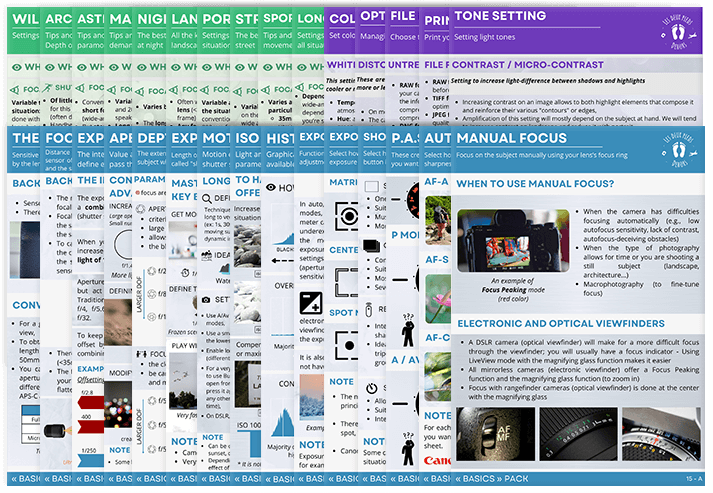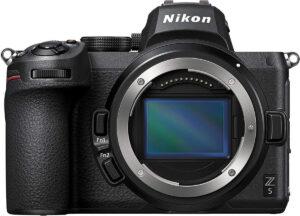Nikon Full frame mirrorless cameras
Last update: 04/05/2024
Our blog continues to grow thanks to you, our readers. This blog may contain affiliate links, which means we can earn a small commission if you make a purchase through them, at no extra cost to you. This helps us to continue to bring you more and support our work!
As you probably know, I’m passionate about camera equipment. I enjoy scouring the internet, searching, keeping up to date with what’s coming out or what’s about to come out. After having mentioned and detailed all the lenses for the Nikon Z mount on a specific page, I’ll now talk about all the Nikon Full Frame cameras offering this new Z mount.
In July 2018, Nikon entered the mirrorless camera market and decided to release a new mount, the Z mount, dedicated to Nikon’s mirrorless cameras. On this page, I will therefore tell you about Nikon’s full frame mirrorless bodies. Later on, I will describe APS-C format mirrorless cameras (there is only the Z50 and Z Fc for now).

Check out my practical photography packs. It's a simple, fun and entertaining way to learn and improve in photography, especially in the field!
For a brief history of the brand’s full-frame mirrorless cameras, Nikon first released the Nikon Z6 and Z7 bodies in July 2018. Then, these same bodies were updated at the end of 2020 and gave rise to the Nikon Z6 Mark II and Z7 Mark II, providing some improvements compared to their big brothers released 2 years earlier. But that’s not all, as they also welcome a new little brother: the Nikon Z5. For your information, all these cameras offer a 5 axis in-body image stabilization.
The purpose of this page is not to flood you with technical data, but rather to try to analyze together Nikon’s strategy, especially to better understand for whom each of these full-frame mirrorless cameras are intended. We will of course talk about photography, but also a little bit about video since some improvements have been made by Nikon over time. In fact, all the latest cameras now offer increasingly quality video. It is important to understand that all manufacturers are giving more and more importance to this, and it is now a real battle that is being launched about video features. Even if I only take photos most of the time, I would still mention in this page this aspect as it will allow us to better understand the orientation of each camera given by the manufacturer.
If you are looking for a lens for your Nikon camera, we have put together a list of the best current Nikon Z lenses. You will find all the details you need to know about these lenses and their specifications.
Nikon Full-Frame mirrorless cameras
Here are all the things you need to consider if you want to know what to look for when choosing your camera.
Nikon Z6
We will start without further delay with the first Nikon full frame mirrorless camera, released a few months ahead of its little brother: the Z7. We are back in July 2018 and Nikon presents us its first full-frame mirrorless, the Z6, offering 24Mpx, ISO sensitivity ranging from 100iso to 51200iso (204800 extended), 273 focusing points, burst rate in Raw at 12 frames per second, ability to shoot in 4k (UHD) at 30 frames per second and a well-provided connectivity (microphone and headphone jack, mini-HDMI, USB C input and remote-control jack). As for memory cards, Nikon has opted for a single XQD card port.
Regarding the sensor definition, 24Mpx is for me a standard for a full-frame sensor. Indeed, this definition has many advantages, including having a number of pixels in the image which allows fairly large prints. But in my opinion, the main advantage is to have files with a proper size, especially when you shoot in Raw. As a reminder, the more Mpx you have on your sensor, the bigger your file will be and the more difficult it will be to process (thus requiring a better, more powerful computer).
The possible burst rate up to 12 frames per second in Raw is not the very best on the market, especially for someone who wants to acquire a camera for sports and action shots. In-body image stabilization will allow you to take pictures with a rather low shutter speed without any motion blur.
Regarding video, this body offers some excellent features. Besides the possibility of filming in 4K at 30 frames per second, it’s especially in terms of connectivity that it shows us its video orientation. User feedback reports speak of a very well defined video, with skin colors being well respected. However, the video orientation does not stop here. The microphone input has a lot to do with it, but especially the headphone one which allows to have an audio return when recording. This may seem trivial but be aware that some cameras more video-oriented are lacking it.
As you will have realized, this Z6 does not do better than its competitors but it is versatile enough to meet all types of needs – especially since the quality/price ratio is very good and has never been as good as today. To know that there is a second version of this camera (Mark II) which improves many elements, particularly the autofocus.
Nikon Z7
While the Z6 is photo/video oriented, the Z7 fully assumes its photographic side, especially with its 45mpx definition, its 14-bit Raw pictures and its 493 focus points. Regarding videos, we are entitled to a 1080p 120 frames per second mode (light crop) and the same connectors than the Z6 has.
As a result, the Z7 is not fundamentally different from the Z6, both in terms of body and connectors. Overall, the Z7 offers almost all the features of the Z6. However, the Z7 has a higher image definition with these 45Mpx, a number of focusing points almost twice as high, allowing the AF to be much more reactive and offering many more possibilities. Also note that the RAWs are 14 bits compared to 12 bits for the Z6 (wider color range) and the Z7 also has a native ISO of 64 ISO, compared to the Z6’s ISO 100.
A very important thing that deserves its own paragraph: the Z7 has no low-pass filter (just like the Z7 Mark II) and this information is unfortunately not very raised although it is very important. Indeed, for those who do not know, the AA filter is used to attenuate moiré effects but reduces the sharpness of the image. In the case of the Z7, we have enough Mpx on the sensor to attenuate this effect and thus remove the low-pass filter that other cameras of this range have. This gives the Z7 a stunning image sharpness.
As you can see, we are here on a high-end camera but not without any compromise. Since the definition of the Z7 is high, the burst rate is a bit slower on this body compared to its big brother (9i/s vs 12i/s). So, the Z7 will be better suited for studio shots, when the Z6 is ideal for outdoor use.
Nikon Z6II & Z7II
At the end of 2020, Nikon decides to update its first two mirrorless cameras. With the Z6II & Z7II, Nikon wanted to solve some “problems” that had been pointed out by users. We are thus indeed on an improved version rather than a release undeniably going further than its predecessor.
One of the first things reviewed was the Z6’s unique XQD slot. Now, there is a double XQD/SD slot which allows you to have a relay function, to backup or even to record pictures on one card and video on another one, which can really be very practical. It should be noted that the XQD format is much more reliable than SD (also offering higher write speed rates) but does cost relatively more. Nikon therefore lets us choose the card we want to use and no longer makes us use only an XQD card, as they did with the Z6.
You should also know that the Z6II and the Z6 (idem for the Z7II and the Z7) have exactly the same body, no buttons have been moved nor added. This is a good point for those who already liked the Mark I, but on the other hand, those who found that some buttons were misplaced will be a little disappointed.
Regarding performance, the Z6 II & Z7 II now feature two processors, allowing a much faster autofocus than before, with face and animal detection even in video. Note that the buffer is also better and we’re closer to 14 frames per second (we’re not so far from sport cameras anymore).
Another point of evolution: Nikon now allows you to charge your camera or to let it be powered while shooting or recording via the USB-C input, which was previously unavailable.
As for the battery, it should be noted that a new standard is now available on the Z6II as well as on the Z7II. However, you have to know that they are backwards compatible in both directions. This is a very good thing we rarely see from other manufacturers, who generally rather change the battery type completely.
Regarding sensor and its definition, nothing changes from that side. Nikon has also announced a vertical grip for the Z6II and Z7II, which unfortunately will not be compatible with the Mark I, since the latter do not have a connector.
So, you will have understood that the Z6II & Z7II are improvements/corrections of the first versions and don’t really change anything. Apart from the double card slot, corrections are very minimal, and most people will be able to do without them in the end.
With reference to video, we are here in the same perspective since Nikon offers nothing more than eye-detection AF and 4K 60f/s (available in February 2021 with a new firmware).
About the Z7II, as for the Z6II evoked above, corrections are cast in the same mold and finally quite minor.
The Z7II is also equipped with a dual XQD/SD slot, a dual image processor (the autofocus is reputed to be much better than the Z7) or a loading via USB-C or power supply. It also comes with the new battery standard and, on the video side, no fundamental change except the availability of 4K60fps. Note that the Mark II also lacks a low-pass filter like its big brother, the Z7.
The Nikon Z5
Now, let’s move on to the newest one, released in the summer 2020. With this new 24.3Mpx camera, Nikon targets photography beginners, people looking for a second high-performance camera at a lower cost, enthusiasts or anyone else wanting to start taking pictures with a full-frame mirrorless camera.
Due to its price positioning at the time of its release, we understand that Nikon wanted to offer this full-frame mirrorless camera at a more affordable price than what was already available on the market. There was indeed still a little place available alongside the Canon EOS RP, to name only one.
Regarding its characteristics, we could consider it as a more-affordable Z6. Among the things to remember, the Z5 offers:
- A double SD slot (cheaper therefore),
- Same shutter speed as Z6/Z7 (1/8000)
- Same number of focusing points (273) as the Z6
- 5 axes in-body image stabilization
- Identical ISO increase as the Z6 (up to 51200).
The main difference with its big brother is the burst rate. Indeed, this one is only 4.5 fps on the Z5 against 12 on the Z6. Regarding video, you will have to settle for Full HD at 60 fps maximum, against 120 on the Z6, and 4k at 30 frames per second. In terms of connectors, nothing has been changed compared to other Z bodies.
As you can see, Nikon had to make some concessions in order to offer a more affordable camera to people wanting to buy a full frame camera at a lower cost (well, everything is relative). Note that the LCD screen quality as well as the EVF are a little inferior compared to the Z6.
The Nikon Z9
During this 2021 winter, Nikon is revealing its long-awaited flagship mirrorless camera: the Nikon Z9. Nikon and Canon have a very important base of sports camera professional users, so it was essential for these brands to offer a monobloc mirrorless camera (with integrated grip) offering the best performance and incorporating the best technologies brands are capable of offering. Sony had already proposed on this segment the A9 and the A1, Canon released its R3, so Nikon was the only one missing to close the market (Panasonic is not very present on this sector, although they will have to do it one day).
The Z9 has impressive and, for some, surprising characteristics. A body monobloc of 1.35Kg, a 45MP stabilized 24×36 sensor like the Z7, a native ISO sensitivity range of 64 to 25600ISO (expandable from 32 to 102400 ISO), a 493 focus AF with human/animal but also vehicles (cars, motorcycles, trains, planes and bikes) recognition, 20fps burst, video mode up to 8K 30p (60p with a later update) as well as 4K 120p without crop, WIFI and Bluetooth, headphone and mic jacks, USB-C charging, a 3.7MP OLED viewfinder like the Z6/Z7, a non-rotatable screen, but tiltable in both orientations (portrait and landscape), 2 XQD compatible CFexpress type B slots…
The most surprising is the abandonment of the mechanical shutter. Nikon has indeed decided, especially thanks to the stacked sensor technology, that the disadvantages of electronic shutter such as rolling shutter (distortion effects because of rapid moves of the camera) or banding (black bands at certain exposure times in certain lighting conditions) will not be a problem on the Z9. However, there is still the possibility in the body to add a sound, adjustable in volume, imitating the noise of a mechanical shutter. A protective flap also closes when the camera is turned off to protect the sensor, as recently offered by Canon and Sony, except that these brands use the mechanical shutter to that end.
The AF, one of the points which were criticized on the other Z’s faced with the competition Sony and Canon, is presented by Nikon as the best ever offered by the brand, including monobloc sports DSLR. Reviews seem to show that Nikon has made up for its delay since we are dealing with an extremely fast and precise AF of high quality, which we hope will be generalized on the successors of Z5/Z6/Z7.
Which difference between these Z bodies?
A few words to end, or rather a summary table that compares the 5 cameras mentioned above. I have summarized all the features I think are interesting to compare, and you will also find links to online retailers to check prices at the time of your reading.
| Body | ISO Range | Weight (g) | Size | Range | AF points | Burst rate (fps) | Views | Wifi (BT) | Vidéo | MP | Low-pass filter | Image processor | Grip |
|---|---|---|---|---|---|---|---|---|---|---|---|---|---|
| Nikon Z6 | 100-51200 (204800) | 675 g | 134 x 101 x 68 mm | Expert | 273 | 12.0 fps | 310 | yes (yes) | 4K 30p | 24,5 MP | YES | EXPEED 6 | NO |
| Nikon Z7 | 64-25600 (102400) | 675 g | 134 x 101 x 68 mm | Pro | 493 | 9.0 fps | 330 | yes (yes) | 4K 30p | 45,7 MP | NO | EXPEED 6 | NO |
| Nikon Z6 II | 100-12800 (50-51200) | 705 g | 134 x 101 x 70 mm | Expert | 273 | 14.0 fps | 340 | yes (yes) | 4K 60p | 24,5 MP | YES | 2x EXPEED 6 | YES |
| Nikon Z7 II | 64-25600 (102400) | 705 g | 134 x 101 x 70 mm | Pro | 493 | 10.0 fps | 360 | yes (yes) | 4K 60p | 45,7 MP | NO | 2x EXPEED 6 | YES |
| Nikon Z5 | 100-51200 (102400) | 675 g | 134 x 101 x 70 mm | Amateur | 273 | 4.5 fps | 470 | yes (yes) | 4K 30p | 24,3 MP | YES | EXPEED 6 | NO |
| Nikon Z9 | 64-25600 (102400) | 1340 g | 149 × 149 × 90 mm | Pro | 493 | 20 fps | 700 | yes (yes) | 8K 30p | 45.7 MP | NO | EXPEED 7 | YES |
If you are looking for a Nikon camera, I recommend you to check out our dedicated page covering the most interesting Z-mount wide-angle lenses. We mention the best choices for a full frame camera (the ones on this page), but also what to choose if you have a Nikon Z APS-C camera.
Which Nikon Z mirrrorless cameras to choose then?
Then, what’s my opinion on these bodies? The objective of this small paragraph is to guide you as best as I can in your future purchase.
Let’s start with the “cheap full-frame mirrorless camera”, the well-known Nikon Z5. In my opinion, it outperforms the few full-frame cameras in its category – I’m referring to the Canon Eos RP in particular. It is for me an excellent choice for those wanting to start with a full frame camera, with good characteristics, a very good image quality and without necessarily spending a fortune. It could also be an excellent camera for a video maker, for example. A positive point, still about price, is the choice of a double SD slot, much cheaper than the XQD format.
The Z6 is for me the all-purpose camera from Nikon and still is today. Of course, it is not perfect, and the improvements made with the Mark II are very welcome – but if you’re looking for a good quality/price ratio, then it is ideal. Indeed, it is very good in photography for its price range, correct in video, and the market is larger today than when these cameras came out.
For all semi-pro and professional photographers (or for people with a little more budget), I can only recommend the Z7 mark II for two reasons: the double XQD/SD card port and the autofocus allowing to follow human eyes but also animals ones, and in a very fast way. Thanks to the 47Mpx of the sensor, you will be able to zoom in the image without loss of quality. The Z7 Mark I remains today a very nice alternative with a falling price.
EDIT of November 2021: worth noting that the last update would have improved the AF performance of the Z5/Z6/Z7 to the level of the Z6/Z7 II, which makes the early versions even more interesting…unless Nikon does the same on the Z6/Z7 II with an update that would bring them to the level of the Z9.
The Z9, displayed at a price of 6000€, targets professional sports and wildlife photographers who can obviously afford it and are looking for the best performance. Some may find this price high, but compared to the competition (Canon R3 and Sony A1), it is well worth the price given its features. In my opinion, this is the perfect camera for Nikon to move this category of professional photographers from DSLR to mirrorless.
I hope this page will be useful for you anyway if you are deeply thinking about buying your full frame camera body. For those wishing to go further, you can take a look at our page dedicated to Nikon APS-C mirrorless cameras, which currently contains the unique Z50/Z Fc cameras.
Of course, this page will be updated as the brand’s new full-frame mirrorless cameras are released.
Don’t hesitate if you have any comments. For those who are still unsure about their choice, don’t hesitate to have a look at the page summarizing everything about Canon full frame mirrorless cameras. You may find what you are looking for.

Written by Sylvain PONS
I've been passionate about photography since 2010, learning as I went along. Today, I dedicate myself to guiding others in their choice of camera gear and sharing a variety of tips to improve their photography skills.
Despite our care, a mistake may have slipped into this article. If you find any, please don't hesitate to let us know so we can correct it as soon as possible and keep our information up-to-date!

















